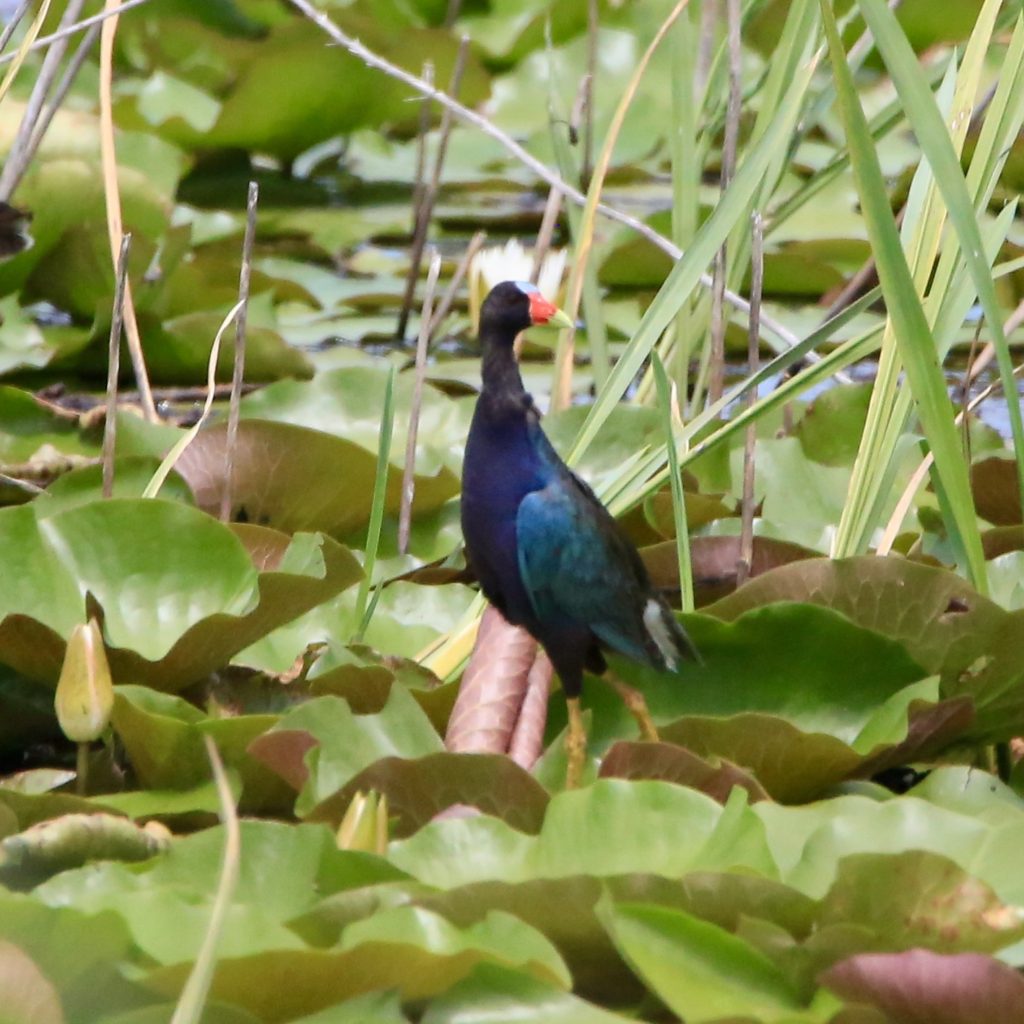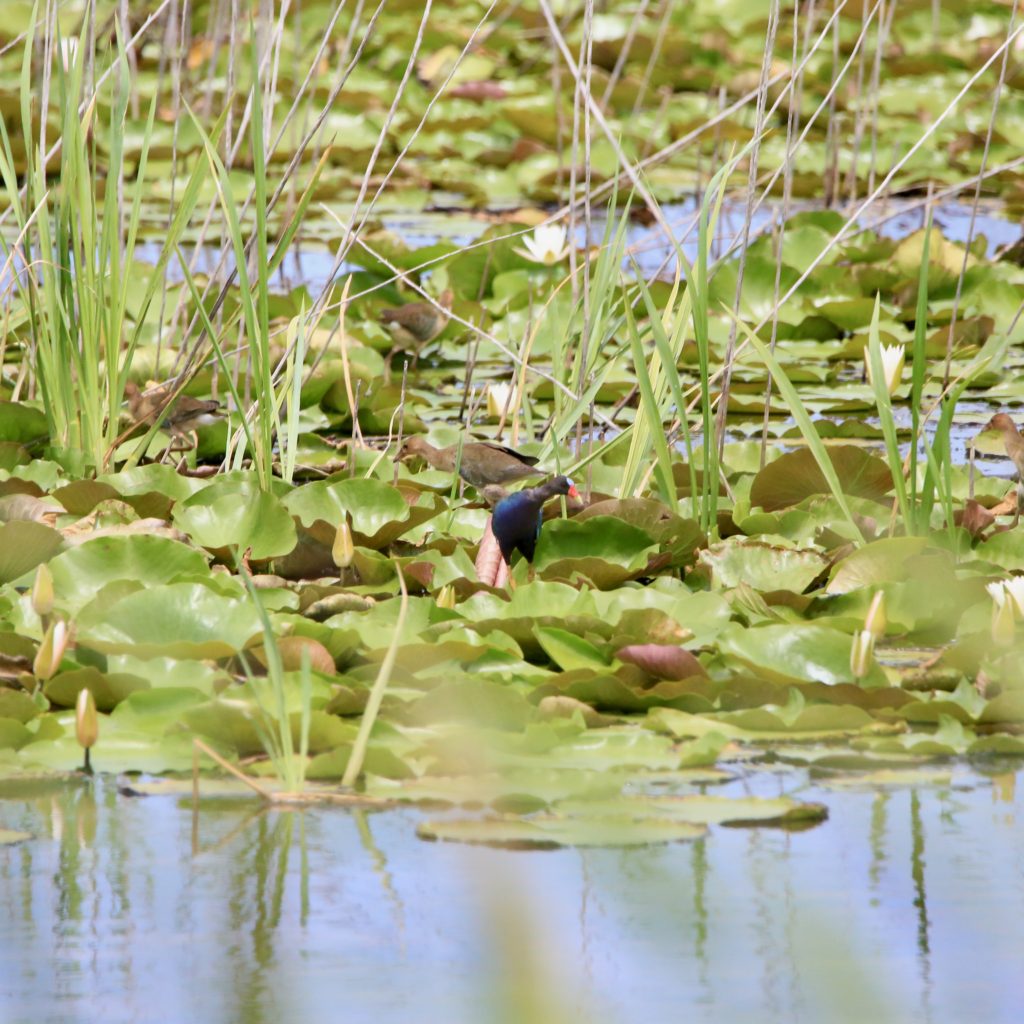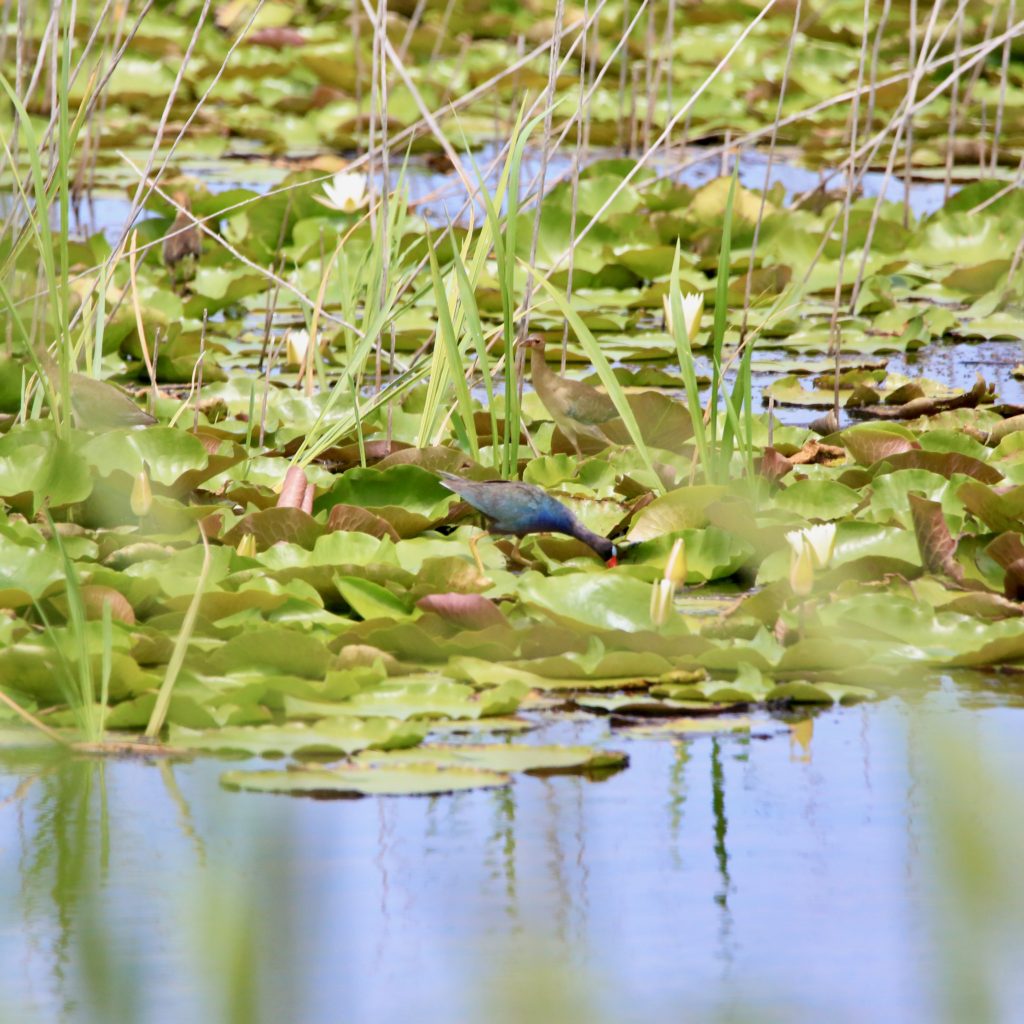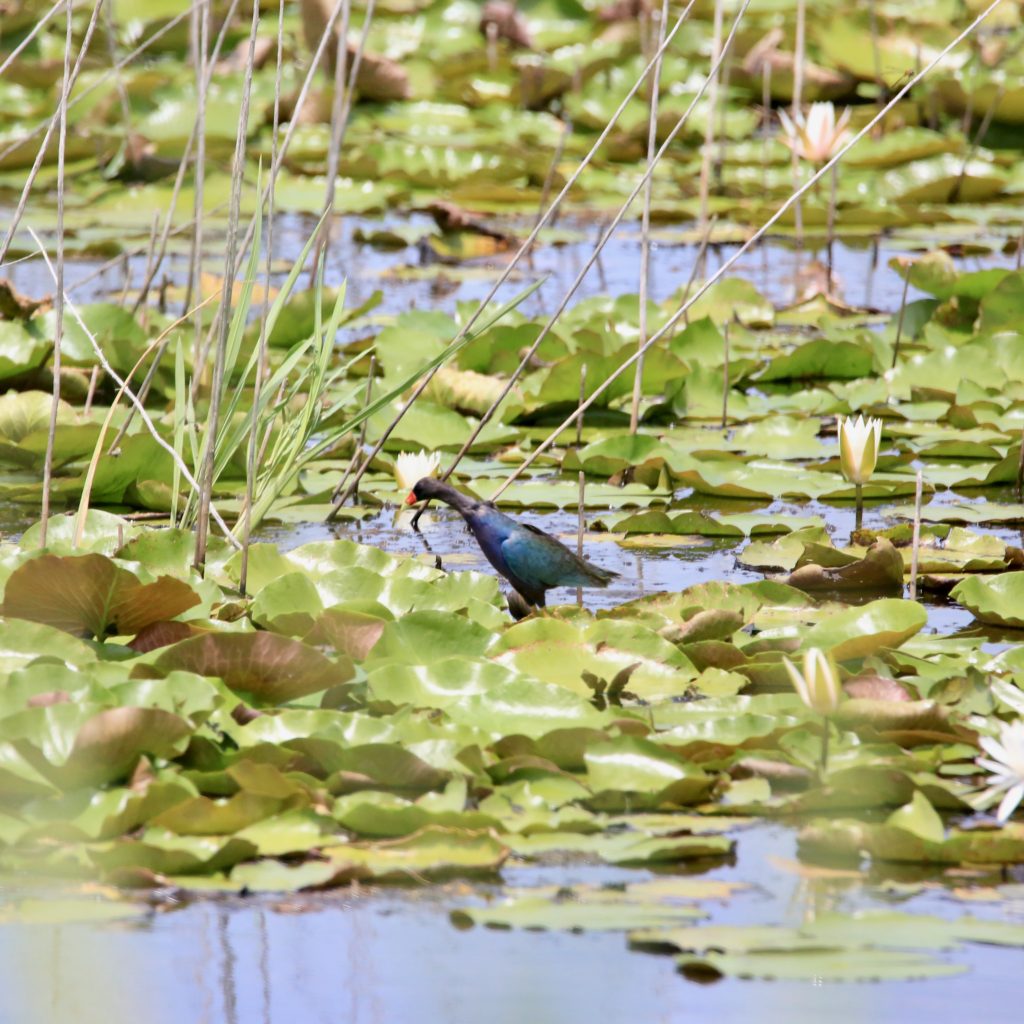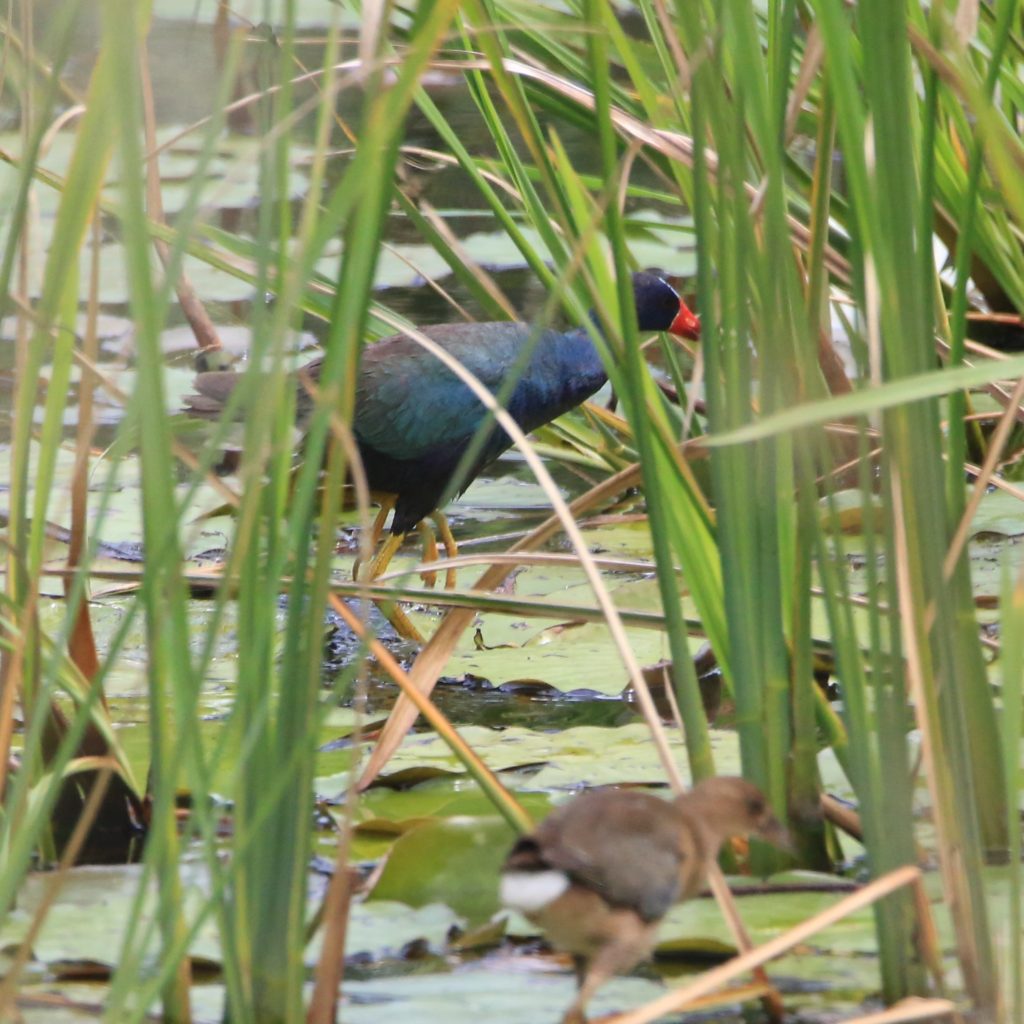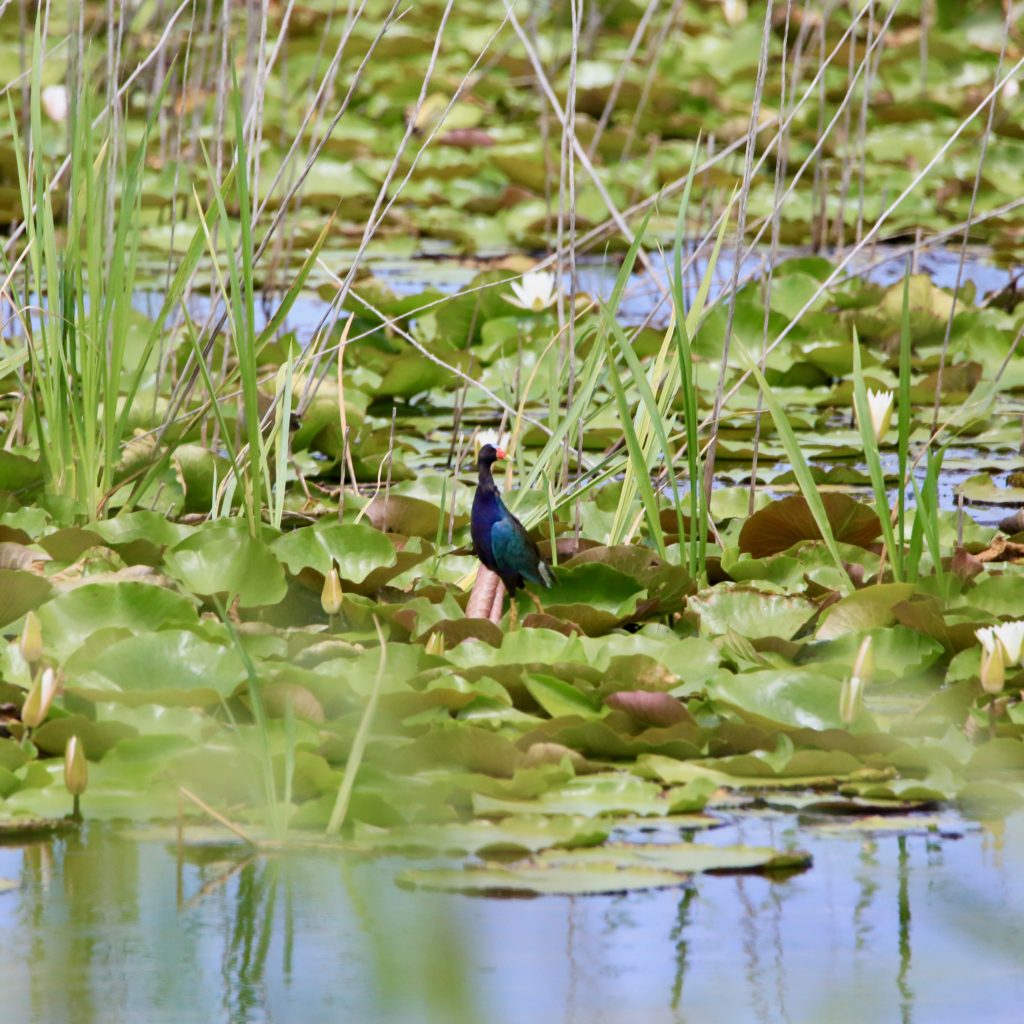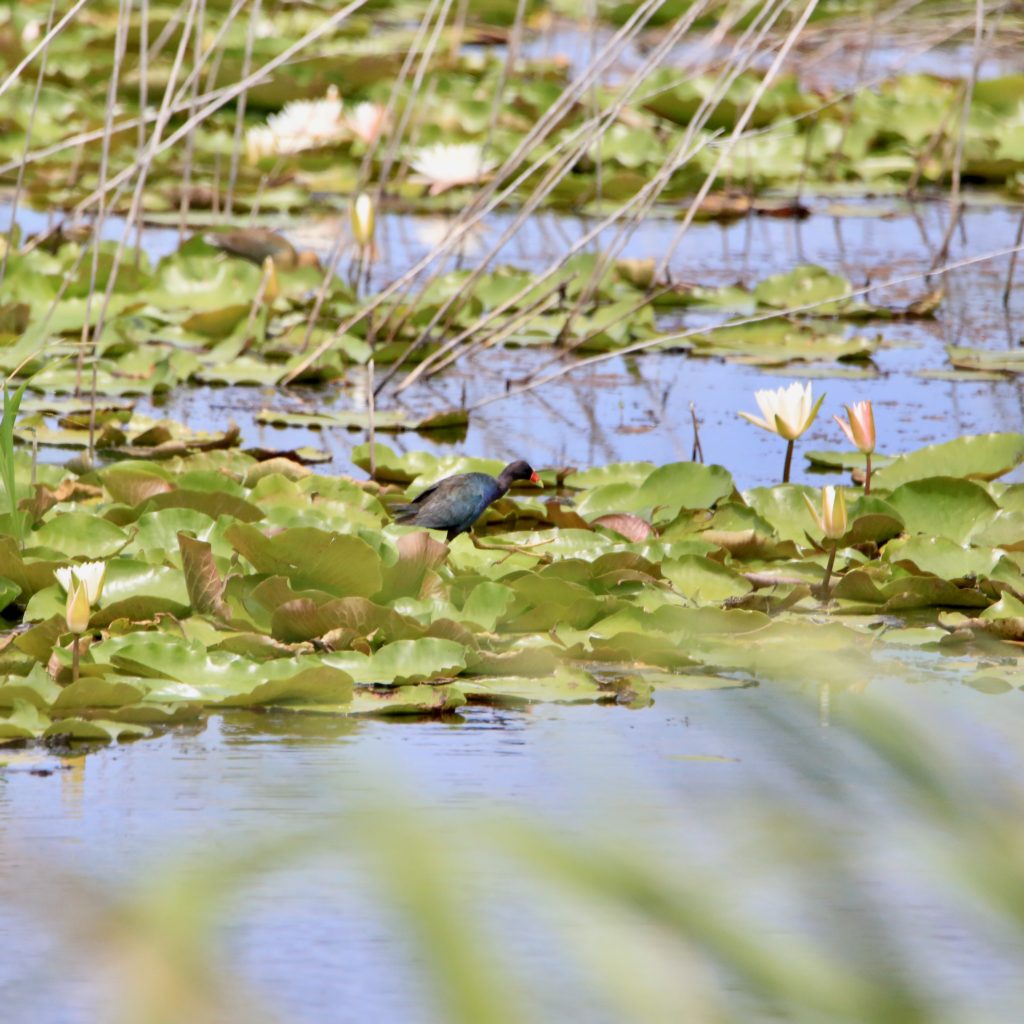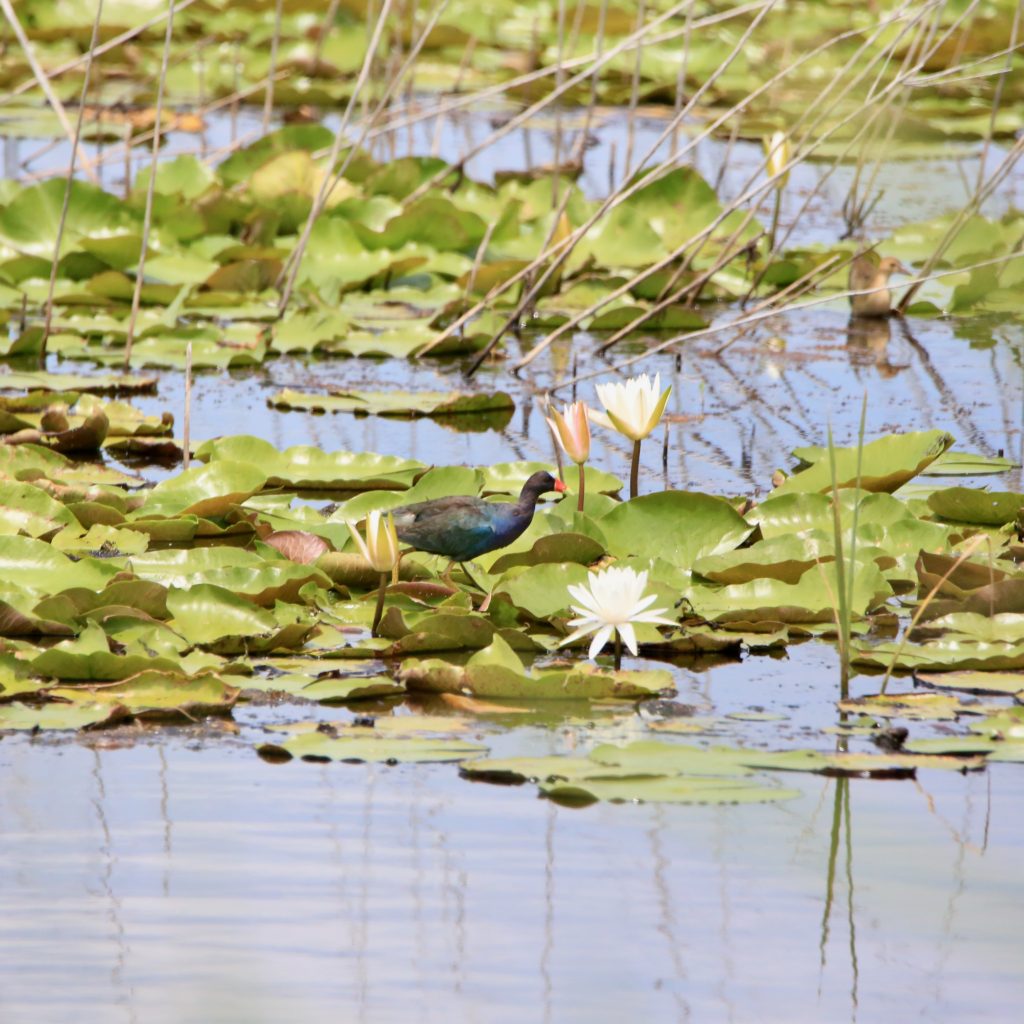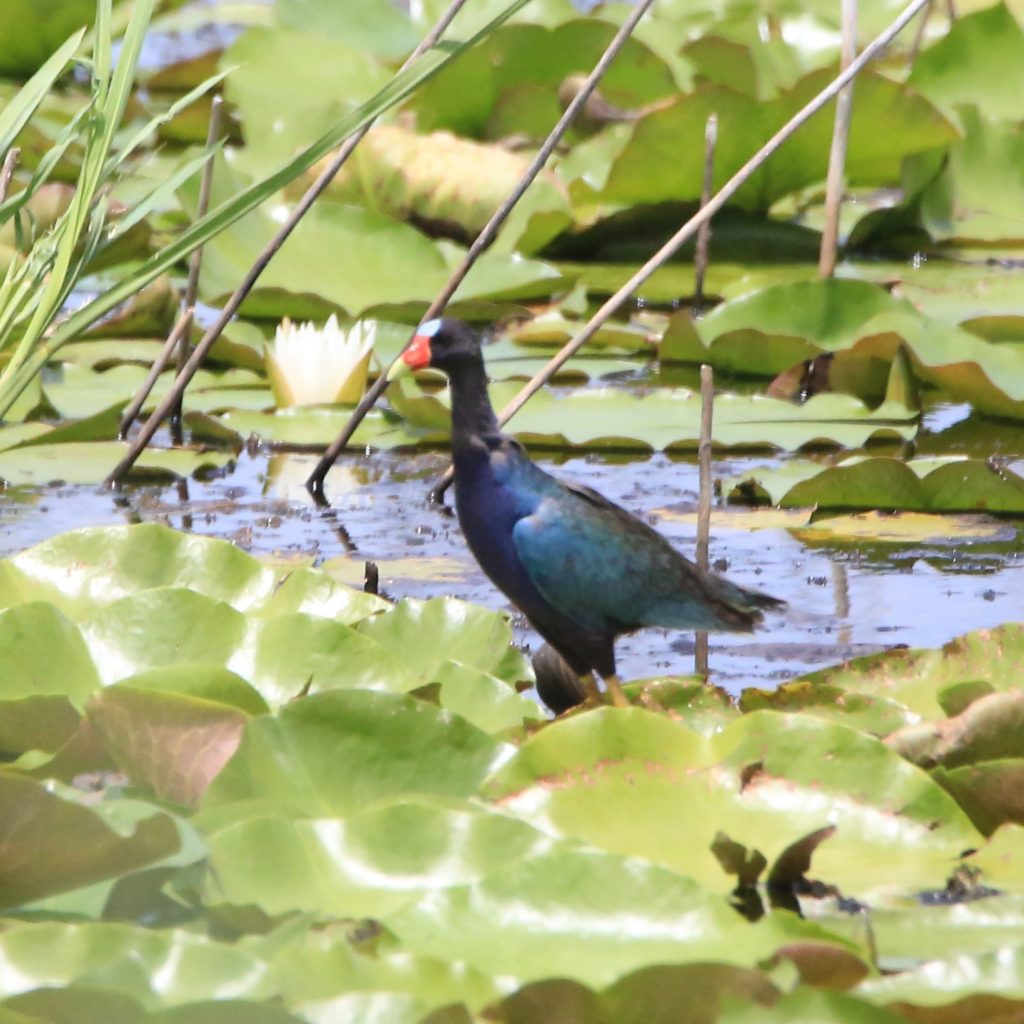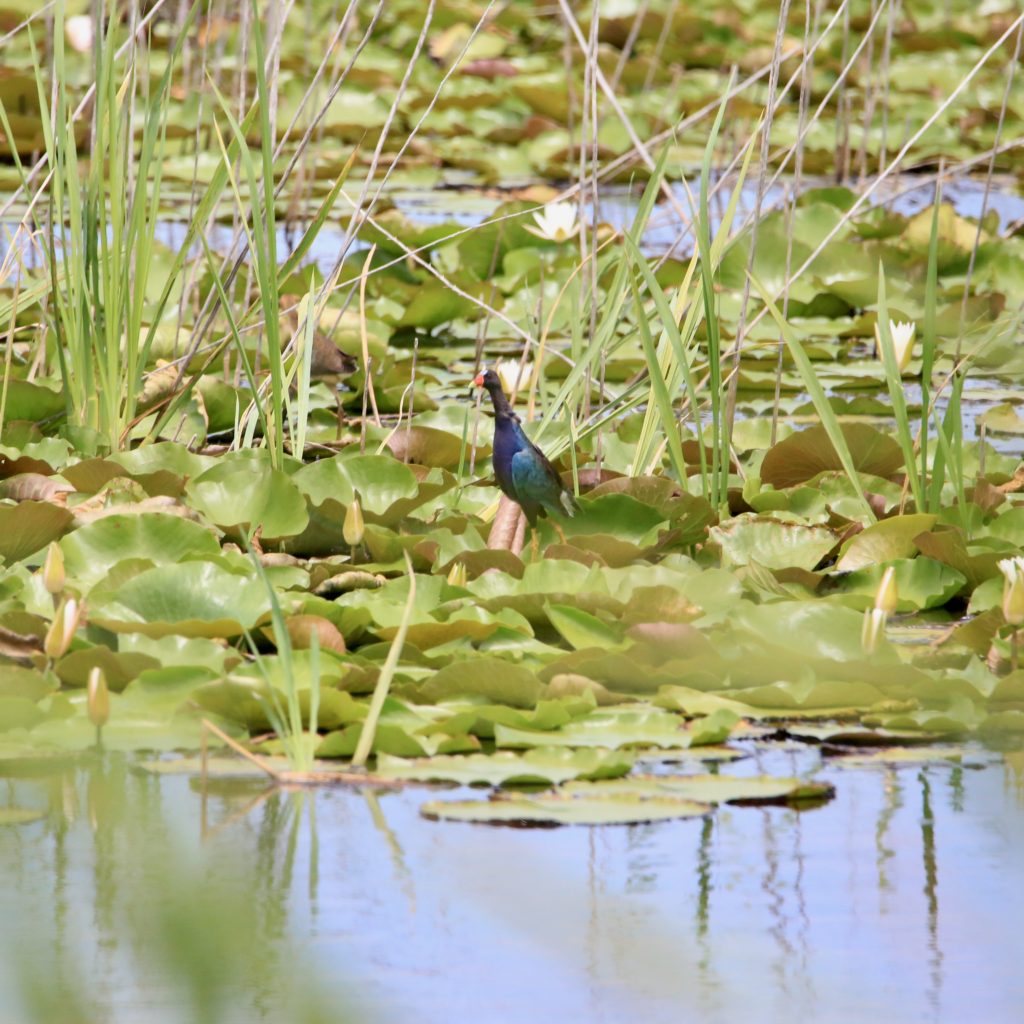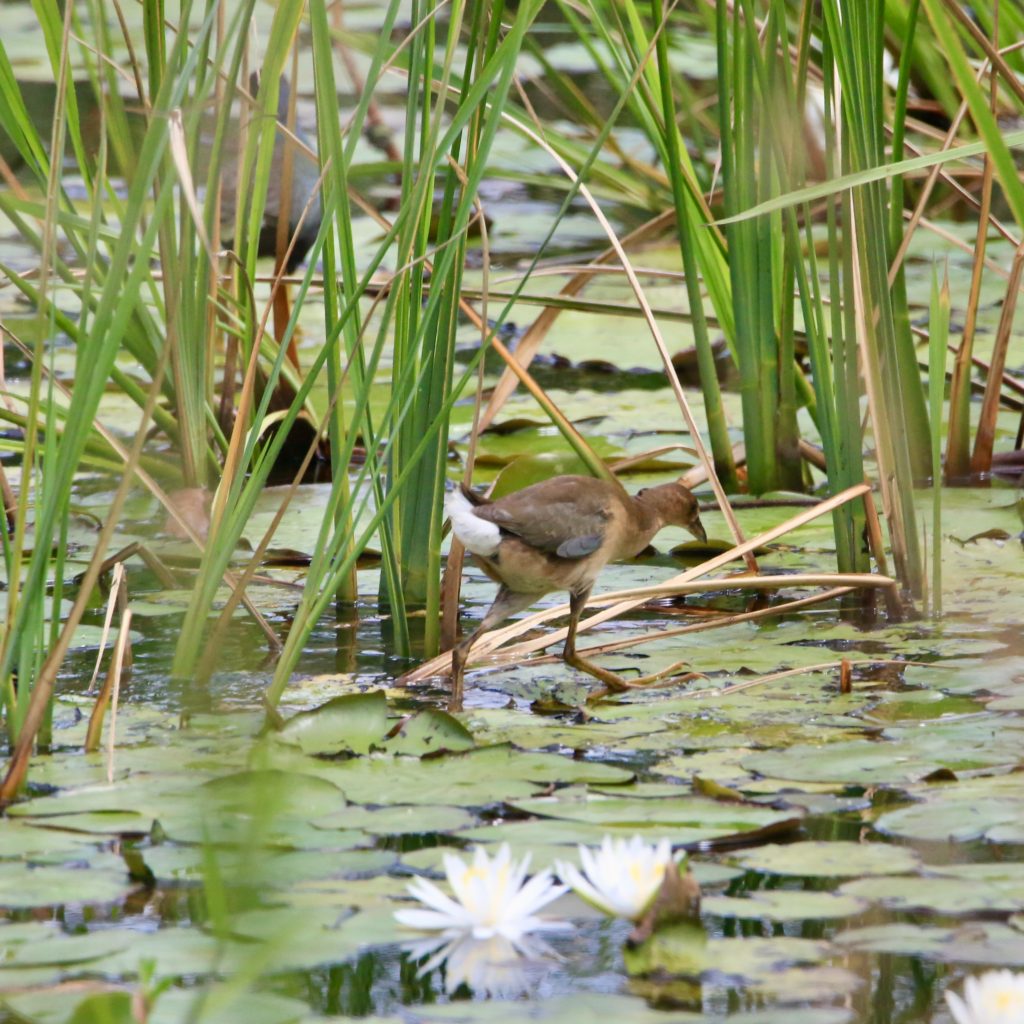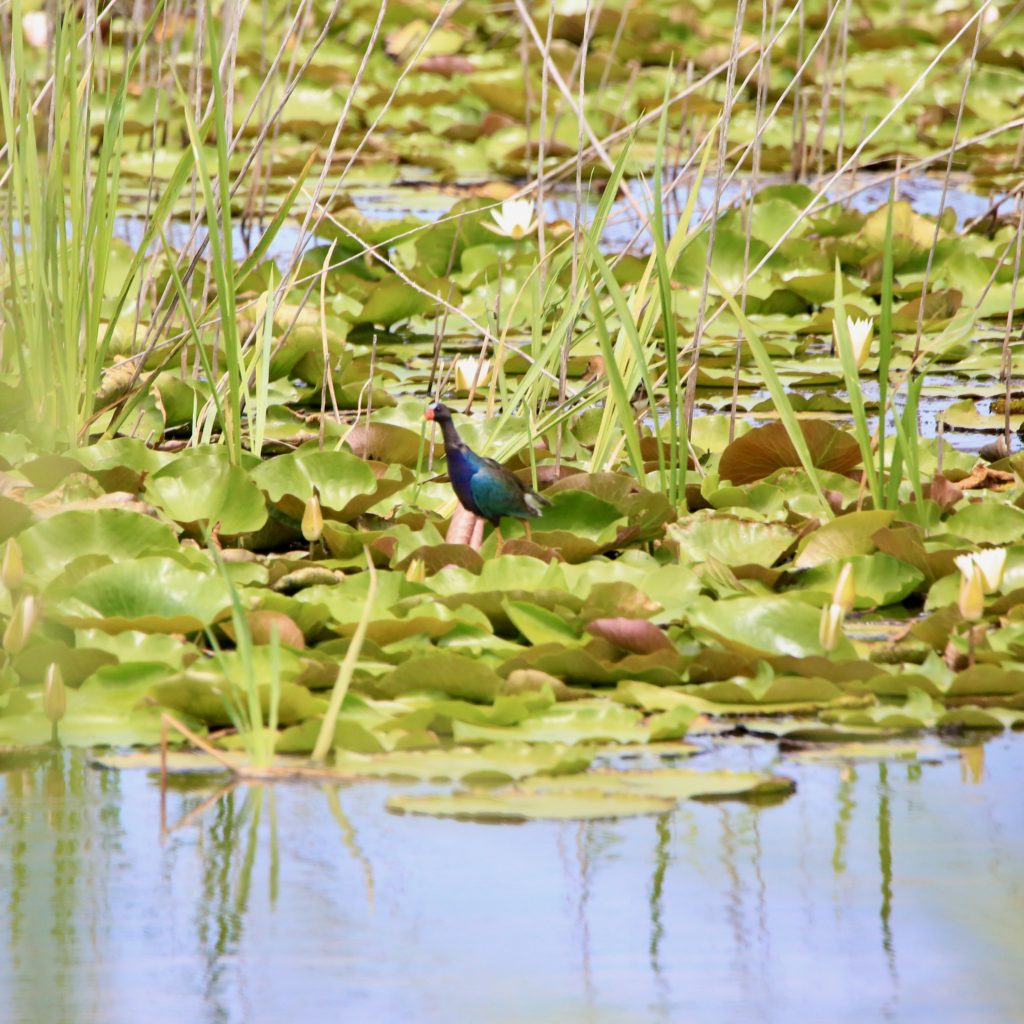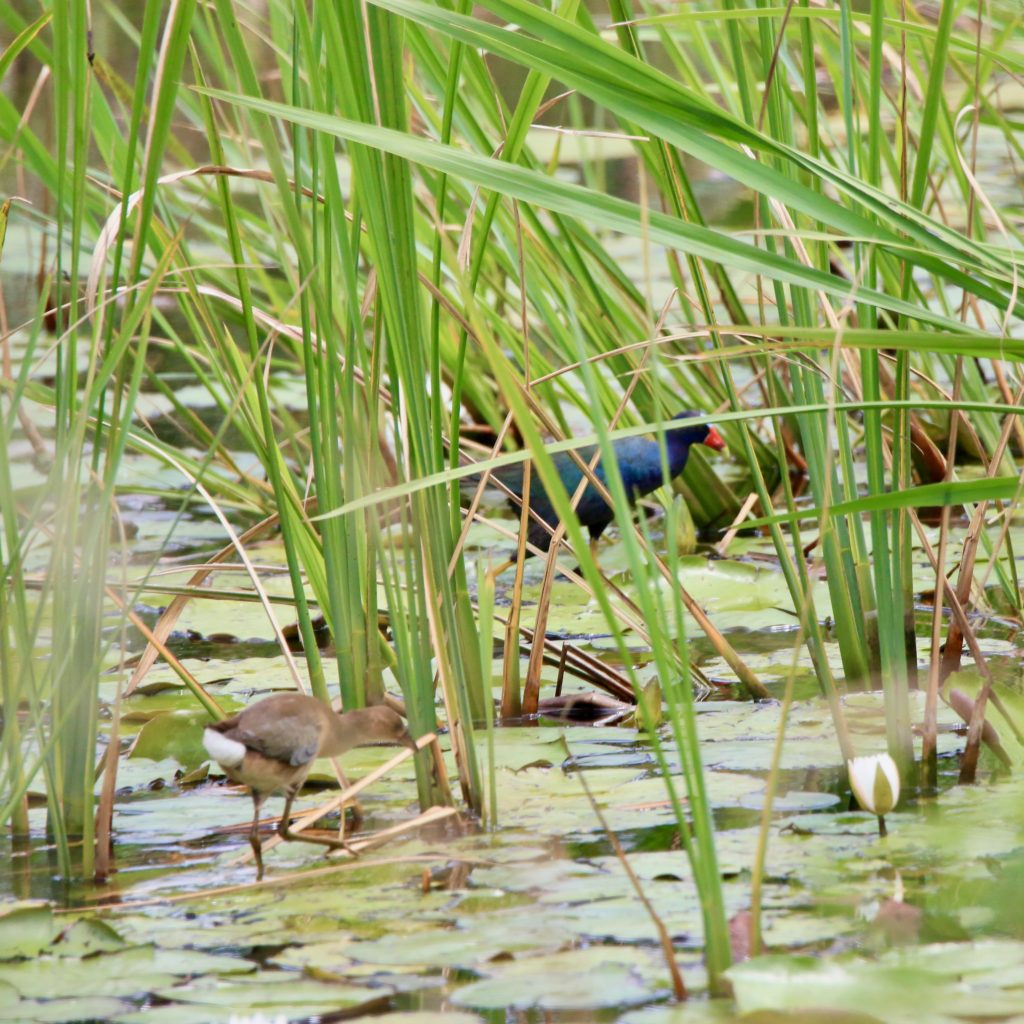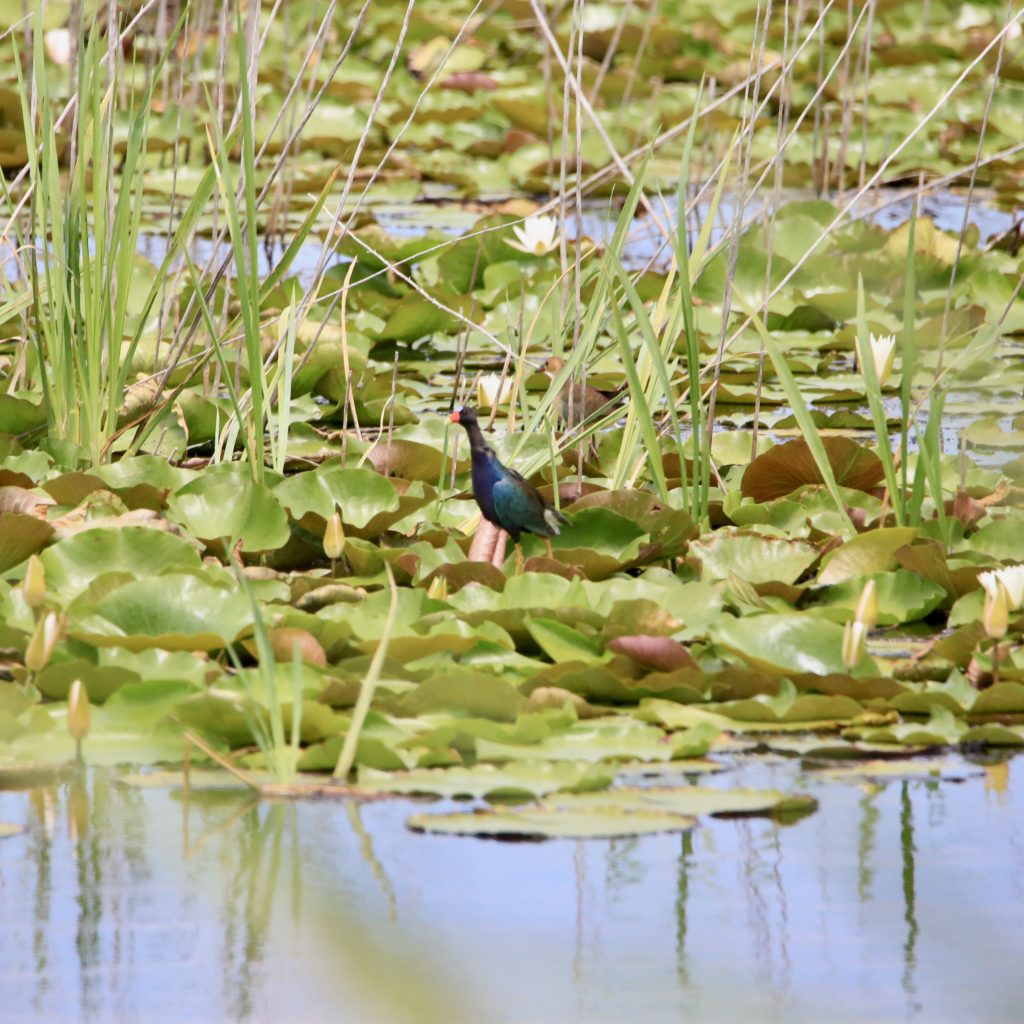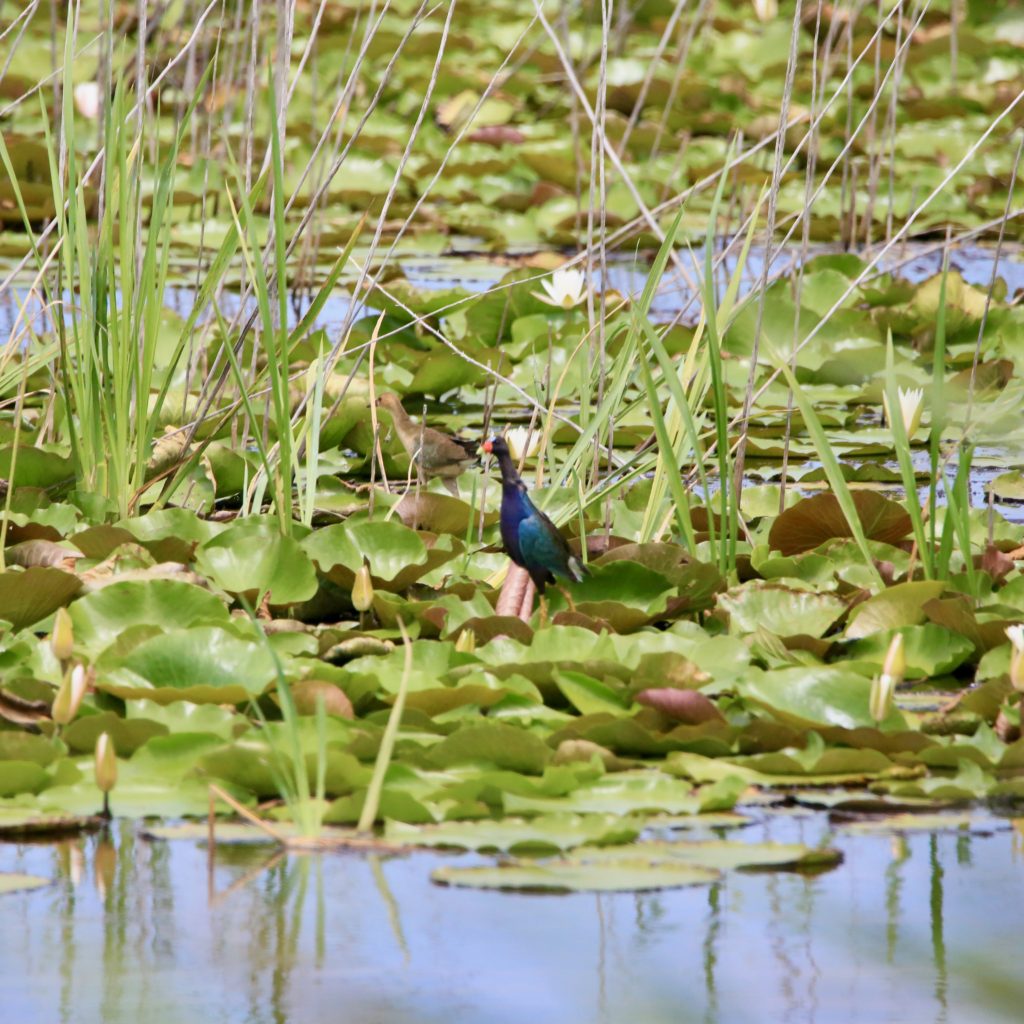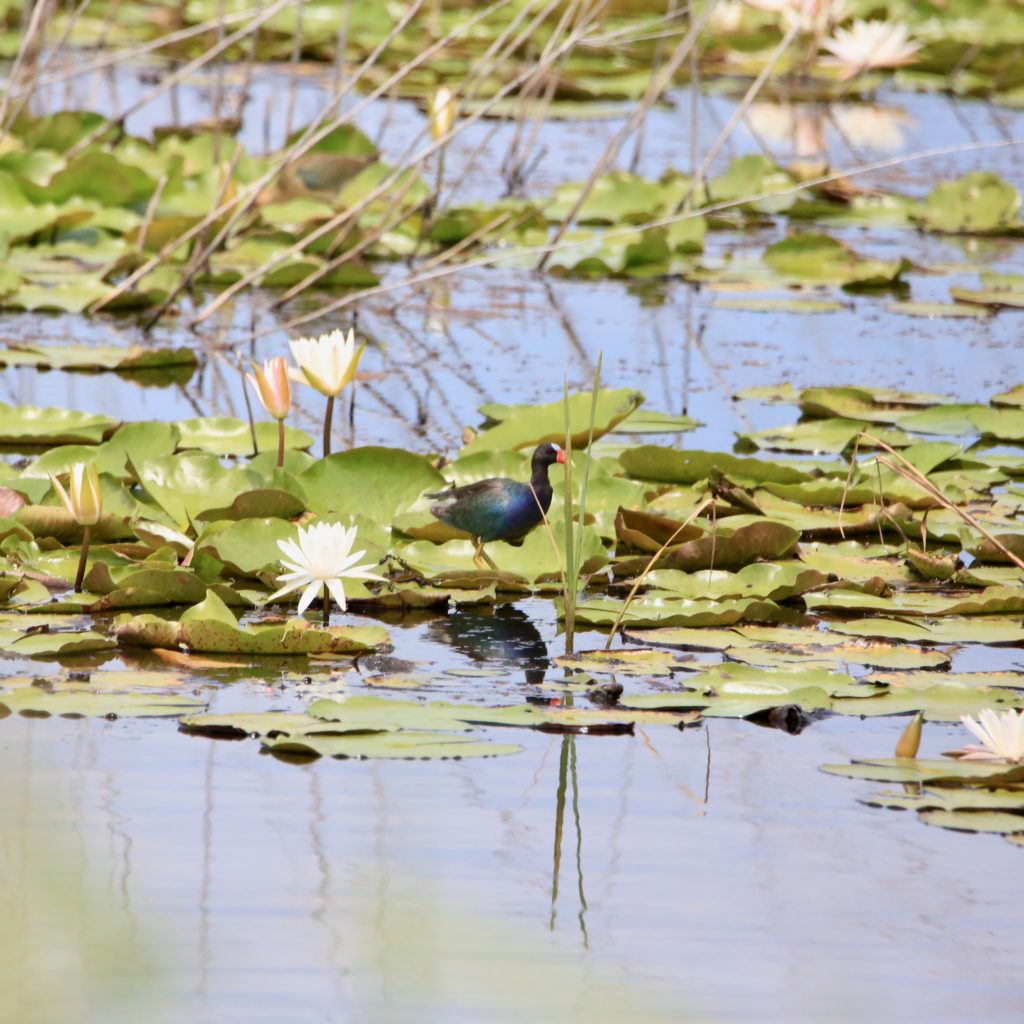
The Purple Gallinule (Porphyrio martinicus) is a swamphen in the genus Porphyrio. They are in the order Gruiformes, meaning “crane-like”, an order which also contains Cranes, Rails, and Crakes. Purple Gallinules are a Rail species, placing them into the family Rallidae. They are also known locally as the yellow-legged Gallinule.
About Purple Gallinules
These birds are medium-sized Rails, and are extremely interesting, with their starkly distinctive looks and their curious behavior. They have an amazing feature that is very characteristic of their species, they are almost iridescent in nature! Their purple-blue plumage, when shined on by light, shines a bright greenish and turquoise. And in dimmer lit scenarios, they turn into a dull brown.
Apart from this, Purple Gallinules have very distinctive behaviors that are characteristic of their species. They have a very interesting call, and also have a curious courting method.
There are lots of interesting things about Purple Gallinules which make them amazing subjects to bird-watchers everywhere. Spotting them is fairly easy because of their size and colors, but it’s always best to know what you’re looking for while you’re bird-watching.
That is precisely why this article will teach you exactly what to look out for while watching Purple Gallinules. It will also teach you a lot about their behavior and mannerisms. You’ll gain a lot of compactly compiled information about these majestic creatures to make your bird-watching journey easier.
● Purple Gallinule Photos, Color Pattern, Song
● Purple Gallinule Size, Eating behavior, Habitat
● Purple Gallinule Range and Migration, Nesting
GET KIDS BIRD WATCHING
Purple Gallinule Color Pattern
Adult Purple Gallinules have purple-blue plumages that will shine green and turquoise when in good lighting. Adults also have a pale blue shield on their forehead, which connects with the red and yellow bill. Darkness or low light can dim the bright purple-blue plumages of adults to make them look dusky or brownish, although the forehead shield color differentiates them from similar species such as Common Gallinules.
Immature Purple Gallinules are a brown-bronze color, with purple feathers on their chests, and their bills and forehead shields are pale in color. Juvenile birds of this species are light brown with hints of green-bronze on the wings and back and white under-tail coverts.
Description and Identification
Lurking in the marshes of the extreme southeastern U.S. lives one of the most vividly colored birds in all of North America. Purple Gallinules combine cherry red, sky blue, moss green, aquamarine, indigo, violet, and school-bus yellow, a color palette that blends surprisingly well with tropical and subtropical wetlands. Watch for these long-
legged, long-toed birds stepping gingerly across water lilies and other floating vegetation as they hunt frogs and invertebrates or pick at tubers.
These birds are chicken-sized with a heavy conical and distinctive bill. They have short tails which are often cocked, compact bodies, and very long legs and toes. You’ll know when a purple gallinule is around when you see floating nests and strange iridescent Alice in wonderland-like birds walking on water like Jesus.
Another very distinctive feature of these birds is their varying array of sounds and calls. They have multiple calls and sounds and are very diverse in their communication.
Purple Gallinule Song
Purple Gallinules, like other Rails, have a remarkable repertoire of vocalizations, most of them rather loud henlike cackling, laughing, or clucking similar to Common Gallinule but usually higher in pitch. Reedy calls are heard from nesting birds: a tinny, hornlike chip, an abrupt “gheek”! that sounds like a Limpkin and “piu”! recalling Smooth-billed Ani and apparently used by parents to call young birds. Lower, more guttural, or muttering calls that sound like “ka” or “kerr” are also described. Bill snapping has also been recorded, and it appears to be associated with contact and safety rather than conflict.
Purple Gallinule Size
Purple Gallinules are a medium-sized rail, measuring on average 10–15 inches in length, spanning 20–24 inches across the wings, and weighing 141–305 grams. Males, averaging 257 grams in mass, are slightly larger than females, that average at 215 grams. They are usually described as averagely “chicken-sized” birds.
Purple Gallinule Behavior
Purple Gallinules forage near the water’s edge, where they walk nimbly on muddy margins, or on aquatic vegetation. They hunt a bit like domestic chickens, walking slowly and investigating the vegetation with outstretched necks, or pecking at fruits or tubers. Like most Rails, Purple Gallinules swim well, and they sometimes perch high in bushes and trees, where their long toes make them agile climbers.
Foraging Purple Gallinules recall a chicken, albeit one with very long legs. They usually walk slowly and carefully, placing the feet gingerly as they survey marsh vegetation for edible plants and animals. As they walk, they often flick the tail up and down as a chicken does. When disturbed they run, swim, or fly away, legs dangling, sometimes landing in trees or shrubs, where they readily climb, balancing with their wings as they move about. Swimming birds jerk the head forward rhythmically as they proceed. They can also dive underwater, remaining hidden except for the bill for long periods. Young birds learning to walk on floating vegetation often appear comical, holding their wings high in the air and racing across the pads quickly when called by a parent. Adults sometimes clash over territories, first posing in an erect posture, then chasing and, rarely, striking each other with feet and bills unless one bird assumes a submissive posture.
During such fights, birds call loudly. Rival males also sometimes strike a bowing pose during or after conflict, with lowered neck and head, raised body and tail, with wingtips touching over the back. Nesting pairs appear to be seasonally monogamous in the United States and defend territories of about 2.5 acres. Nonbreeding birds are usually
found in areas less suitable for nesting, and they are not territorial. They often nest in the same areas as Common Gallinules, which appear to be dominant over them.
Purple Gallinule Diet
Purple Gallinules are omnivorous in nature. They eat a wide variety of plant and animal matter, including seeds, fruits, and leaves of aquatic and terrestrial plants, also insects, frogs, snails, spiders, worms, fish. At times, they also eat the eggs and young of other birds.
Like most Rails, Purple Gallinules eat a great variety of foods. Typically more plants than animals. The water-lily family, including American lotus, produces flowers and fruits that gallinules consume readily, and they also eat flowers, leaves, and tubers of invasive exotic plants such as water hyacinth and hydrilla, as well as rice. Seeds of many different
sedges and other aquatic plants such as buttonbush, water willow, sawgrass, smartweed, and pickerelweed are also important food items. Purple Gallinules also prey on spiders, mollusks, beetles, bees, worms, snails, dragonflies, leeches, ants, grasshoppers, and moth larvae, as well as frogs, small fish, and eggs and nestlings of other birds.
They forage while walking on land, while climbing through marsh vegetation or waterside shrubs or trees, or while swimming. They are extremely adaptable creatures when it comes to foraging and hunting for food. Their stature also makes it extremely easy for them to switch between different mediums while looking for food.
Purple Gallinule Habitat
Purple Gallinules inhabit freshwater marshes, mostly places that hold water year-round and that have sedges, grasses, and rushes. They also inhabit dense stands of emergent floating vegetation such as American lotus, water shield, spatterdock, pickerelweed, arrowhead, water pennywort, and various water lilies. These floating plants provide a habitat both for foraging and nesting.
Nonbreeding birds of this species are often seen in more open environments than breeding birds, which require more extensive aquatic vegetation for suitable nest sites. Purple Gallinules use lakes, ponds, impoundments, reservoirs, and wet rice fields to varying extents, so long as there is food and adequate vegetation for cover and foraging. In South America, migrants have been found in Andean wetlands at elevations as high as 13,385 feet. Migrating individuals crossing the Gulf of Mexico often appear on oil drilling platforms, on barrier island beaches, and in gardens.
Range and Migration
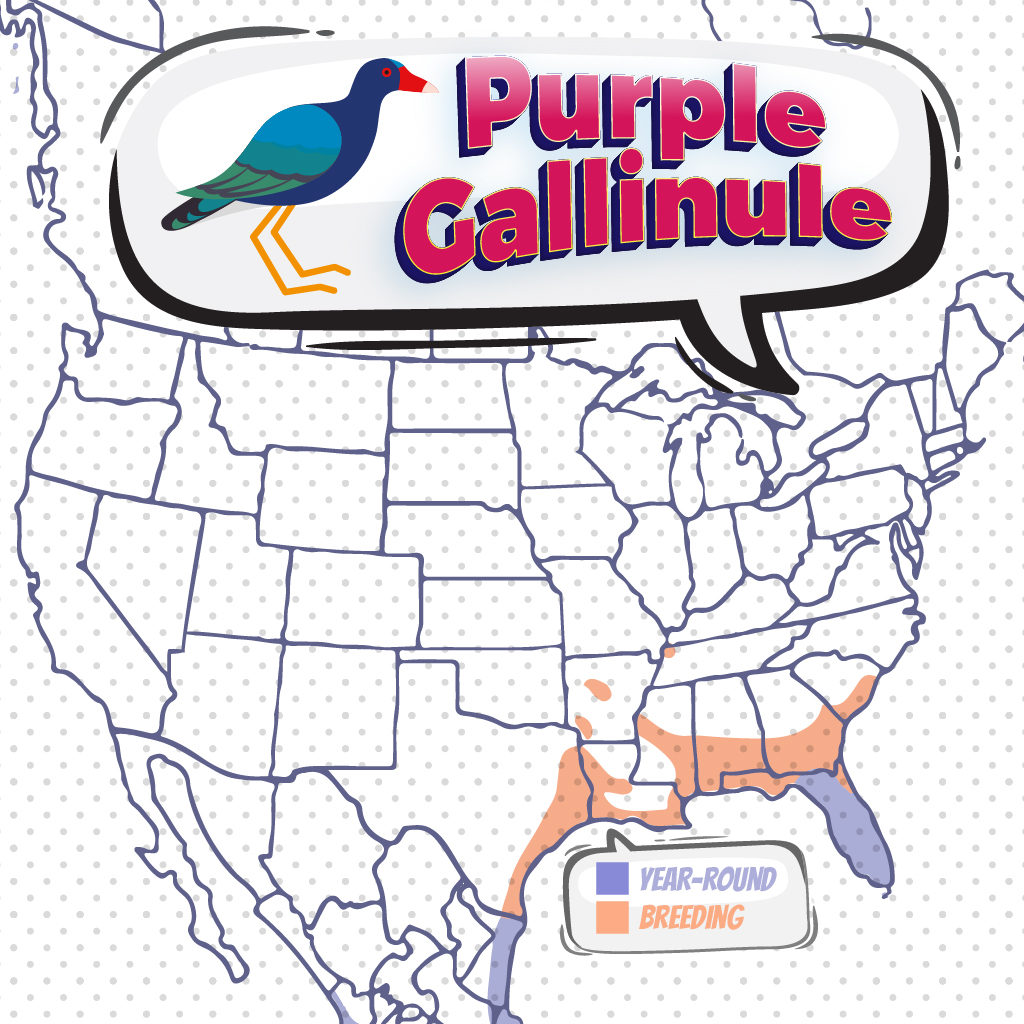
Purple Gallinules are short-distance migrants and are usually an extremely residential bird species. Most of the Purple Gallinules that breed in the U.S. migrate as far as Central America for the winter, but some remain in Florida year-round. Just like Warblers, they typically migrate at night.
Purple Gallinule Lifecycle
Purple Gallinules lay 6-8 eggs, and sometimes even 5-10 eggs. Their eggs are buff with brown spots. The eggs incubate for 22-25 days. Once they hatch, the young of this species may leave their nests shortly after hatching, and move to a second nest. In feeding young, parents are often assisted by other birds (as many as 8) and these “helpers” are evidently all previous offspring of the breeding pair. Juveniles less than 10 weeks old may help feed newly hatched chicks, making this species extremely fast-learning and growing and also very independent a species. The young are capable of flight at roughly 9 weeks.
Once they leave their nests, they live nice and fulfilling lives in their community, living lives that span approximately as long as 22 years!
Nesting
The breeding behavior of Purple Gallinules has been studied mostly in Costa Rica. They may breed at any season in the tropics, but only in spring and summer in North America. Their nest sites are in dense marsh growth, over water that is often several feet deep. Both males and females build the nest and are often made of cattails, grasses, sedges, firmly anchored to standing marsh vegetation, at a water level or 1-3 inches above it. These birds think ahead, and are often build extra nests just in case.
Nests and their placement vary tremendously, some are loose collections of vegetation made on floating vegetation so they move around during windy periods. Others are anchored in reeds or other emergent vegetation, placed near water level, or in vegetation as high as 2.6 feet above the water. Purple Gallinules build up to 4 different
nests, though they use only one for egg-laying and incubation. Both males and females apparently participate in the construction of the nest.
Their nests are a cup-shape platform of rushes, sedges, and grasses, normally into a crotch of standing marsh vegetation or onto floating vegetation. Nests are roughly 11 inches across and 3.5 inches deep. Some nests have a half-roof, to conceal the incubating parent and provide some protection from the elements. Others have a small ramp of vegetation leading to the nest. When the young hatch, a parent sometimes moves them to one of the additional nests.
Anatomy of a Purple Gallinule
Purple Gallinules have purple-blue plumages over their necks, breasts, heads, and their bellies. They have red eyes, yellow legs, and their bills are red with a yellow tip. The frontal shields, which are located just above their bills, are pale blue and the back and upper wings are covered in green and blue plumage. Both the males and females are similar in appearance.
They have an iridescent coating on their plumage, making them shift color in different lighting. In well-lit scenarios, their purple-blue plumages shine with bright green and turquoise shades. In dimly lit scenes, their plumages go from vibrant purple-blue to a simple and dull brownish color, mimicking their surroundings and the weather that surrounds them. This allows them to camouflage with their marshy surroundings.
Final Thoughts
Purple Gallinules are decently easy to spot in the wild if you’re in their habitat and specifically looking for them. They truly are a wonderful sight to behold for bird-watchers everywhere. Their plumage makes them seem like the empaths of the bird family, absorbing and reflecting their surroundings so wonderfully to stay camouflage in the scene.
When looking for these birds, you basically have to look out for colorful, iridescent, and psychedelic-looking chicken-sized birds. You can spot them when you see multiple nests floating in the water, especially if there’s more than one.
Purple Gallinules are, thankfully, listed as “least concern” in the IUCN, making them a species that is very abundant in the population. This means that we can watch these birds for generations without having to worry about their extinction. But, we should also remember to protect their habitats and tread carefully while watching them in order to preserve their status and population.
Now that you know more about their habitat and behaviors, you can identify Purple Gallinule in the wild quite easily. These birds truly look magical, and would be an incredible sight to behold as a bird-watcher!
Ornithology
Bird Watching Academy & Camp Subscription Boxes
At the Bird Watching Academy & Camp we help kids, youth, and adults get excited and involved in bird watching. We have several monthly subscription boxes that you can subscribe to. Our monthly subscription boxes help kids, youth, and adults learn about birds, bird watching, and bird conservation.
- Kids Bird Watching Monthly Subscription$10.00 / month
- Kid & Adult Bird Watching Starter Pack Subscription$10.00 / month and a $72.00 sign-up fee
- Kids Bird Watching Starter Pack Subscription$10.00 / month and a $19.00 sign-up fee
Bird Watching Binoculars for IdentifyingPurple Gallinules
The most common types of bird watching binoculars for viewing Purple Gallinules are 8×21 binoculars and 10×42 binoculars. Bird Watching Academy & Camp sells really nice 8×21 binoculars and 10×42 binoculars. You can view and purchase them here.
- Birding Binoculars$49.99
- Kids Binoculars$13.99
Purple Gallinule Iron On Patches
Kids, Youth, and Adults love to collect our Bird Watching Academy & Camp iron-on patches. Our bird-watching patches help you keep track of the birds you have seen and identified. You can also display the patches on our Bird Watching Academy & Camp banners.
The Purple Gallinule is a great iron-on patch to start your collection with. The patches are durable and can be sewn on or ironed on to just about anything.
- Purple Gallinule Iron on Patch$2.99
- Bird Banner$10.99
Purple Gallinule Stickers
Stickers are a great way for you to display your love for bird watching and the Purple Gallinule. We sell a monthly subscription sticker pack. The sticker packs have 12 bird stickers. These sticker packs will help your kids learn new birds every month.
Bird Feeders ForPurple Gallinules
There are many types of bird feeders. Bird feeders are a great addition to your backyard. Bird feeders will increase the chances of attracting birds drastically. Both kids and adults will have a great time watching birds eat at these bird feeders. There are a wide variety of bird feeders on the market and it is important to find the best fit for you and your backyard.
Bird HousesForPurple Gallinules
There are many types of bird houses. Building a bird house is always fun but can be frustrating. Getting a bird house for kids to watch birds grow is always fun. If you spend a little extra money on bird houses, it will be well worth every penny and they’ll look great.




